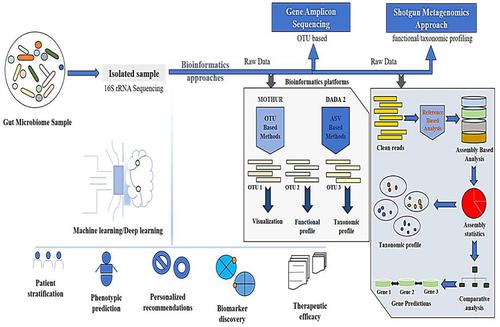当前位置:
X-MOL 学术
›
Chem. Bio. Drug Des.
›
论文详情
Our official English website, www.x-mol.net, welcomes your feedback! (Note: you will need to create a separate account there.)
Understanding gut microbiome‐based machine learning platforms: A review on therapeutic approaches using deep learning
Chemical Biology & Drug Design ( IF 3 ) Pub Date : 2024-03-16 , DOI: 10.1111/cbdd.14505 Shilpa Malakar 1 , Priya Sutaoney 1 , Harishkumar Madhyastha 2 , Kamal Shah 3 , Nagendra Singh Chauhan 4 , Paromita Banerjee 5
Chemical Biology & Drug Design ( IF 3 ) Pub Date : 2024-03-16 , DOI: 10.1111/cbdd.14505 Shilpa Malakar 1 , Priya Sutaoney 1 , Harishkumar Madhyastha 2 , Kamal Shah 3 , Nagendra Singh Chauhan 4 , Paromita Banerjee 5
Affiliation

|
Human beings possess trillions of microbial cells in a symbiotic relationship. This relationship benefits both partners for a long time. The gut microbiota helps in many bodily functions from harvesting energy from digested food to strengthening biochemical barriers of the gut and intestine. But the changes in microbiota composition and bacteria that can enter the gastrointestinal tract can cause infection. Several approaches like culture‐independent techniques such as high‐throughput and meta‐omics projects targeting 16S ribosomal RNA (rRNA) sequencing are popular methods to investigate the composition of the human gastrointestinal tract microbiota and taxonomically characterizing microbial communities. The microbiota conformation and diversity should be provided by whole‐genome shotgun metagenomic sequencing of site‐specific community DNA associating genome mapping, gene inventory, and metabolic remodelling and reformation, to ease the functional study of human microbiota. Preliminary examination of the therapeutic potency for dysbiosis‐associated diseases permits investigation of pharmacokinetic‐pharmacodynamic changes in microbial communities for escalation of treatment and dosage plan. Gut microbiome study is an integration of metagenomics which has influenced the field in the last two decades. And the incorporation of artificial intelligence and deep learning through “omics‐based” methods and microfluidic evaluation enhanced the capability of identification of thousands of microbes.
中文翻译:

了解基于肠道微生物组的机器学习平台:使用深度学习的治疗方法综述
人类拥有数万亿个处于共生关系的微生物细胞。这种关系使双方长期受益。肠道微生物群有助于许多身体功能,从消化食物中获取能量到加强肠道的生化屏障。但微生物群组成和可进入胃肠道的细菌的变化会引起感染。一些方法,例如独立于培养的技术,例如针对 16S 核糖体 RNA (rRNA) 测序的高通量和元组学项目,是研究人类胃肠道微生物群组成和分类学表征微生物群落的流行方法。微生物群的构象和多样性应通过位点特异性群落 DNA 的全基因组鸟枪宏基因组测序来提供,关联基因组作图、基因库存以及代谢重塑和重组,以简化人类微生物群的功能研究。对生态失调相关疾病的治疗效力的初步检查可以研究微生物群落的药代动力学-药效学变化,以升级治疗和剂量计划。肠道微生物组研究是宏基因组学的整合,在过去的二十年中影响了该领域。通过“基于组学”的方法和微流体评估将人工智能和深度学习结合起来,增强了识别数千种微生物的能力。
更新日期:2024-03-16
中文翻译:

了解基于肠道微生物组的机器学习平台:使用深度学习的治疗方法综述
人类拥有数万亿个处于共生关系的微生物细胞。这种关系使双方长期受益。肠道微生物群有助于许多身体功能,从消化食物中获取能量到加强肠道的生化屏障。但微生物群组成和可进入胃肠道的细菌的变化会引起感染。一些方法,例如独立于培养的技术,例如针对 16S 核糖体 RNA (rRNA) 测序的高通量和元组学项目,是研究人类胃肠道微生物群组成和分类学表征微生物群落的流行方法。微生物群的构象和多样性应通过位点特异性群落 DNA 的全基因组鸟枪宏基因组测序来提供,关联基因组作图、基因库存以及代谢重塑和重组,以简化人类微生物群的功能研究。对生态失调相关疾病的治疗效力的初步检查可以研究微生物群落的药代动力学-药效学变化,以升级治疗和剂量计划。肠道微生物组研究是宏基因组学的整合,在过去的二十年中影响了该领域。通过“基于组学”的方法和微流体评估将人工智能和深度学习结合起来,增强了识别数千种微生物的能力。



























 京公网安备 11010802027423号
京公网安备 11010802027423号